



Bluetongue 2009: Special Report
Last year there were more than 24,000 cases of bluetongue in France whilst none were reported in England. Can we pull off the 'great escape' again this year, asks Dr Dave Cavanagh of the Institute for Animal Health? To answer this question his colleagues glanced back at 2008 and published their findings in the National Farmers Union members' magazine, British Farmer & Grower.Where the virus got to in 2008:
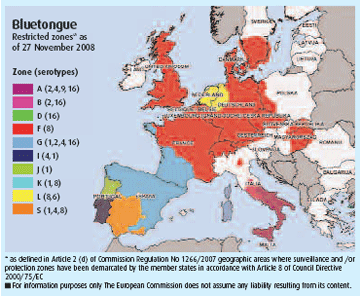
The map shows the restriction zones in place for various serotypes of bluetongue virus (BTV) by November of last year.
Serotype 8 was detected from Spain to Sweden, and from Britain to Hungary. Serotype 1, which is in Spain and Portugal, had travelled northwards as far as Brittany, posing a threat to our south-west counties.
The most surprising event was the sudden appearance of serotype 6, detected in October, in parts of the Netherlands and neighbouring regions of Germany. This serotype had never previously been detected in Europe. Restriction zones for four other serotypes remain in place in Italy, one of which, serotype 4, is also in southern Spain and Portugal.
So many ruminants were infected by BTV-8 in the relatively small countries of Belgium and Netherlands during 2007 that many of the survivors were immune in 2008. A combination of this, and the implementation of a successful vaccination programme in 2008, resulted in many fewer outbreaks.
However, in France and Germany there was much more scope for spread of BTV-8, it having been concentrated in northern and western parts, respectively, in 2007. By November, France and Germany had reported over 24,000 and approximately 2,500 new outbreaks, respectively, for the year.
In these countries the disease had spread faster than the vaccination programmes, emphasising the need for early and extensive vaccination. France also experienced over 4,000 outbreaks caused by BTV-1. Over this winter France has been implementing a compulsory vaccination campaign against both serotypes 1 and 8. Dr Anthony Wilson
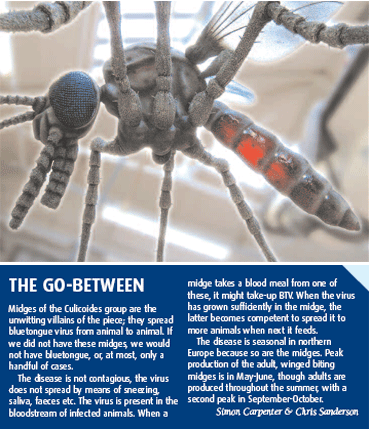
What we can do in 2009: Vaccination
Heartfelt congratulations are due to those farmers, especially in the east and south of the UK, who vaccinated their stock against BTV-8 last year.
That undoubtedly was a major reason why we had no bluetongue disease in 2008. We had feared an escalation following the introduction of BTV-8 in 2007, similar to that experienced in mainland Europe.
But there are still worries ahead; BTV-8 continues to be present on the near continent, BTV-1 entered Brittany in the autumn and BTV-6 then arrived in Holland. With so much bluetongue infection on the Continent we must take precautionary measures to protect our livestock, by vaccinating again.
Farmers are encouraged to vaccinate with the available BTV-8 vaccine, and not to wait until a bivalent BTV-1 and BTV-8 becomes available. Defra believes that a bivalent vaccine is unlikely to be available until after summer.
Even if a bivalent vaccine was available, it would be illegal to use it unless Defra declared England a BTV-1 Protection Zone, or decided to declare a new "blue zone" that may allow vaccination in areas where disease is not circulating.
Stock vaccinated last year against BTV-8 must be vaccinated again this year, though only one shot will be required, irrespective of whether for cattle or sheep. Cattle that were not vaccinated last year will need to be vaccinated twice, sheep only once. In all cases, it is important to get animals vaccinated and protected prior to the 2009 bluetongue transmission season which will start in April/May.
There is no vaccine available against BTV- 6, a situation likely to endure throughout this year. We have only one line of defence: not importing from risky areas on the Continent. Drs Chris Oura & Philip Mellor
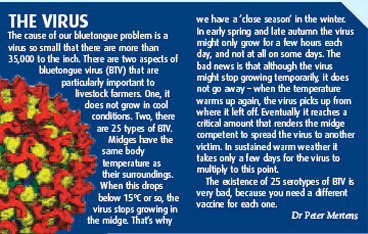
What we can do in 2009: Careful imports
The risks inherent in importing stock from the Continent were illustrated by the detection of BTV-8 in some stock imported into Britain in 2008.
Fortunately, it did not spread, probably thanks to vaccination. In autumn one farmer imported cattle that proved to be carrying remnants of BTV-1, the first, and so far the only, known cases of this serotype in the UK. As a precaution these animals were culled.
If you import BTV-1 positive livestock and they are culled, there is no compensation. Careful live animal importation practices are currently the only defence we have against the latest arrival in Europe - BTV-6.
Avoid importing BTV susceptible livestock from countries where BTV is circulating, unless you are absolutely sure and have the evidence that they fully comply with movement requirements.
Of course, midges might bring BTV-6 (and also 1 and 8) to the UK. To defend against this possibility we must be extra vigilant. If BTV-6 does get over here, we need to deal with it without delay, and before it can spread. Drs Chris Oura & Philip Mellor
Trojan Horses
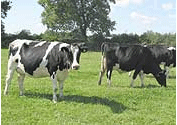
Although midges are by far the most common way in which BTV is spread, another route came to light when some pregnant cows were imported into Northern Ireland early last year.
Testing revealed that some of the cows had foetuses that were infected with BTV. The calves were born healthy, though with virus in them. Some of the other cows, that were negative for the virus at the time of importation, became positive. How so?
We believe that this is likely to have come about by the cattle eating the infected afterbirths. These would have contained large amounts of virus, sufficient for the cows to become infected. So, this episode highlighted another way in which BTV can be spread by moving livestock; in the foetus of a cow that has itself recovered from infection. Drs Chris Oura & Philip Mellor
When the wind blows...

Weather is a key component of the risk posed by bluetongue.
It was easterly winds on the night of 4/5 August 2007 that are believed to have first brought bluetongue virus (type 8) infected midges to East Anglia from Belgium.
Whilst the summer of 2008 could not be described in the UK as a "scorcher", there were plenty of hours in the summer months, around dusk and dawn, when midges would have been feeding. There were tens of occasions when midges could have been carried in the wind from infected animals, mainly in northern France to the south coast of England.
In particular animals along the south coast from Kent to Dorset could have been bitten by midges which became airborne anywhere from Calais to the Cherbourg Peninsula. So, why were there no cases of bluetongue recorded?
It could have been for a number of reasons, but primarily it is believed that the high degree of take-up of vaccine (type 8) in previously affected areas severely reduced the numbers of susceptible livestock; vaccination not only stopped cases originating from infected midges blown into the UK, but also stopped transmission from virus already over-wintering in the UK.
What does 2009 hold for farmers on the east and south coasts?
Well, it is certain that the wind will blow from the Continent to the UK, and temperatures during the summer months will be warm enough for virus replication and midge activity. Will BTV types 1 and 6 over-winter and emerge as new threats to unprotected UK livestock?
If they do then unvaccinated livestock from Cornwall to Kent could be at risk from type 1, and from Kent to Lincolnshire from type 6. Of course, if types 1 and 6 were to spread on the Continent, then more English counties might be under threat of incursion. The possibility of more cases of type 8 cannot be ignored either. The only significant thing that we can do to protect our stock from the consequences of being bitten by infected midges is to vaccinate them.
While the cold snap of December and January, with long periods of sub-zero temperatures in many areas of northern Europe, including the UK, will have killed the last adult midges which were living out-of-doors, midge larvae will survive and be ready to emerge as soon as temperatures rise again in the Spring.
This combines with the possibility of survival of virus in foetuses, possibly in the UK and certainly on the Continent, where thousands of animals got bluetongue last year. Infected newborn ruminants this spring are likely to be a potent source of virus that will be spread by new midges.
If the Spring and Summer turn out to be warm, like the above-average temperatures experienced in northern Europe, including Britain, for the past two years, or even warmer like 2006, then there is a distinct danger that if the virus were to re-establish itself in the UK or near Continent then we could be faced with an explosive increase in outbreaks in un-protected livestock. So, don't delay vaccination. John Gloster and Laura Burgin, Met Office and IAH
Finally...
The situation facing British livestock farmers this year is more complex than previously; three serotypes of bluetongue virus are ranged against us on the near Continent.
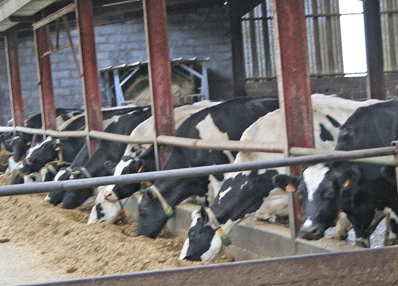
The most significant risk remains BTV-8 and vaccination against BTV-8 should protect us from that serotype, if we practice it widely; likewise BTV-1, if vaccine is available later this year.
The risk of BTV-1 depends on the French authorities' success in vaccinating against it this winter, and we will keep a close eye on this situation and advise Defra on necessary proactive measures.
However, vaccination will require the establishment of zones with movement controls. Currently we benefit from a single BTV-8 zone where movement and trade can continue normally, so there are economic considerations to be taken into account when deciding how zones should be established in order to allow vaccination under current EU rules.
The only protection against BTV-6 is to avoid importing stock from risky areas, and to be vigilant; midges could bring it, and BTV 1 and 8, with them. Our proactive approach in Britain last year brought success; let's repeat that this year.
March 2009


